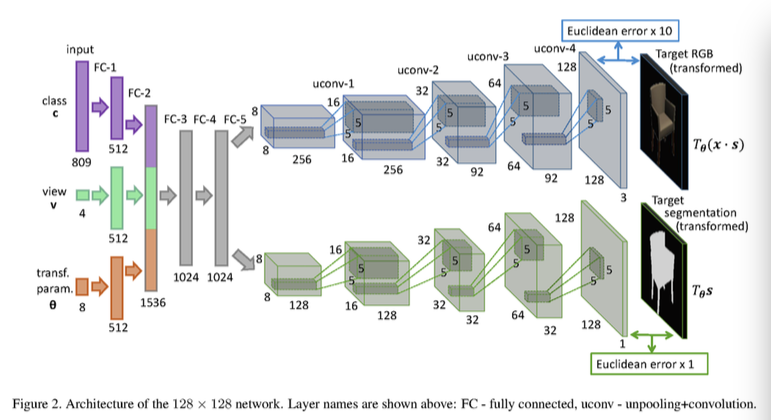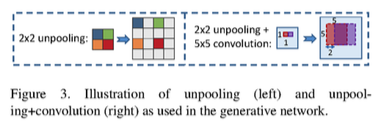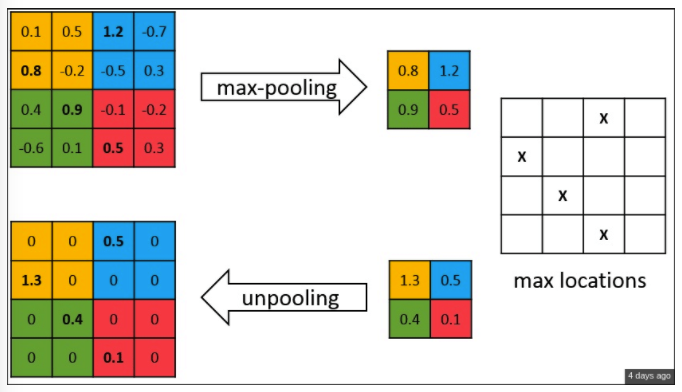转载必须著名出处和链接,否则追究法律责任
首先,来到本文的读者肯定跟我一样觉得Unpool操作非常重要,因为在Autoencoder 等需要用反向神经网络来实现invert反转来构建原始数据,例如我们可以用倒过来的卷机神经网络从特征generate出一些椅子的图片,而且生成的图片跟之前的图片一定使不同的。倒过来的神经网络架构图及应用例子如下图的例子,左边给出特征的描述找到对应的特征,最后生成椅子图片。就像是一个脑洞大开的你,输入照片描述:宋仲基聚光的小眼睛,雷佳音丧萌丧萌的眉毛,潘粤明呆萌乖巧的腿....,然后就能给你生成一批符合这些描述的照片。

目前Tensorflow对卷积的反向有现成的函数可以调用,解卷积tf.nn.conv2d_transpose大家可以自行查找。不幸的是unpool操作,也就是max-pool的反向操作并没有现成的函数,本文不仅将已有的方法做一下总结,并将代码放出来,供大家参考。在实现的时候,我翻了很多中英文的在线问答都没有解决方案,因为Tensor cannot be accessed by index,只有 numpy array才可以用index访问,而我们知道tensor 转 numpy array的唯一方式就是执行它,比如sess.run(Tensor),或者Tessor.eval(),因为Tensor实际上像个容器,没有内容,只有执行一下才有数据,而run Tensor的这件事在我们训练模型定义层结构的时候是不符合逻辑的,当你有好多层,需要定义一个反卷积层服务于整个网络的训练,你不可能单独为某一层拿到sess和feed_dic。大家也可以自己试试,欢迎留言讨论。据我们所知,本博文是首次给出Tensorflow unpool代码,希望对大家有帮助。
1. 文献中关于Unpool的两种方法
- 方法1: we perform unappealing by simply replacing each entry map by an s*s block with the entry value in the top corner and zeros elsewhere. This increases the width and the height of the feature map s times. We used s=2 in our networks. 如果max-pool是将一个2*2的方格里最大值拿出,那么反向池化可以将该值赋给2*2的左上角元素,其它置为0.






- 方法 2: In the convnet, the max pooling opera- tion is non-invertible, however we can obtain an ap- proximate inverse by recording the locations of the maxima within each pooling region in a set of switch variables.http://www.matthewzeiler.com/wp-content/uploads/2017/07/arxive2013.pdf it records the locations of maximum activations selected dur- ing pooling operation in switch variables, which are em- ployed to place each activation back to its original pooled location https://www.cv-foundation.org/openaccess/content_iccv_2015/papers/Noh_Learning_Deconvolution_Network_ICCV_2015_paper.pdf 这个方法比方法1应该更准确了一些,因为在反向池化的时候将max pool 选择的最大值的 index拿到,那么将值再放回原位置,其它置为0。


https://arxiv.org/pdf/1506.02351.pdf
2. 代码实现
2.1 如何实现 Access tensor by index 修改/读取 Tensor的某个元素
为了完成代码,第一个摆在我们面前的事实就是:tensor cannot be accessed by index。而我们必须要做的就是,Access tensor by index 修改/读取 Tensor中的某个元素,我们把这一节单独拿出来,是因为这个问题相信是很多其它需要通过index访问tensor的代码都会遇到的。
解决方案:既然不能用 tensor[1][2]来读取index为(1,2)的元素(这里tensor是一个创建的tensor对象的名字)那么我们可以借助其它方式巧妙的完成它,也就是拆分为两个步骤:指定index来读取tensor的值 (tf.expand_dims),为tensor 指定index的位置赋指定的值(使用tf.SparseTensor(indices, values, shape))这两个方法大家如果要用,自行百度/google很多通俗易懂的博文可以参考。
2. 最后,放上实现上述方法1 反池化的 代码
def unpool2(pool, ksize, stride, padding = 'VALID'):
"""
simple unpool method
:param pool : the tensor to run unpool operation
:param ksize : integer
:param stride : integer
:return : the tensor after the unpool operation
"""
pool = tf.transpose(pool, perm=[0,3,1,2])
pool_shape = pool.shape.as_list()
if padding == 'VALID':
size = (pool_shape[2] - 1) * stride + ksize
else:
size = pool_shape[2] * stride
unpool_shape = [pool_shape[0], pool_shape[1], size, size]
unpool = tf.Variable(np.zeros(unpool_shape), dtype=tf.float32)
for batch in range(pool_shape[0]):
for channel in range(pool_shape[1]):
for w in range(pool_shape[2]):
for h in range(pool_shape[3]):
diff_matrix = tf.sparse_tensor_to_dense(tf.SparseTensor(indices=[[batch,channel,w*stride,h*stride]],values=tf.expand_dims(pool[batch][channel][w][h],axis=0),dense_shape = [pool_shape[0],pool_shape[1],size,size]))
unpool = unpool + diff_matrix相信有了这个代码,方法2大家实现起来就很容易了。
但是这种方法非常慢,非常非常慢,所以实现反池化的过程,可以用下面的方法代替:
# PI is the 4-dimension Tensor from above layer
unpool1 = tf.image.resize_images(PI, size = [resize_width, resize_width], method=tf.image.ResizeMethod.NEAREST_NEIGHBOR)
另外还有两种unpool的方法:
def max_unpool_2x2(x, output_shape):
out = tf.concat_v2([x, tf.zeros_like(x)], 3)
out = tf.concat_v2([out, tf.zeros_like(out)], 2)
out_size = output_shape
return tf.reshape(out, out_size)
# max unpool layer 改變輸出的 shape 為兩倍
# output_shape_d_pool2 = tf.pack([tf.shape(x)[0], 28, 28, 1])
# h_d_pool2 = max_unpool_2x2(h_d_conv2, output_shape_d_pool2)def max_unpool_2x2(x, shape):
inference = tf.image.resize_nearest_neighbor(x, tf.pack([shape[1]*2, shape[2]*2]))
return inference其他参考:
https://github.com/jon-sch/tensorflow/commit/16cd223508fa234cd4ae0f2fa4d63ee812d6cada
https://ithelp.ithome.com.tw/articles/10188326